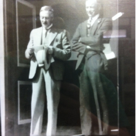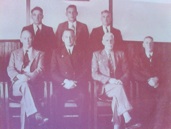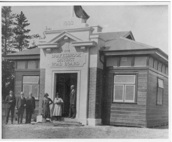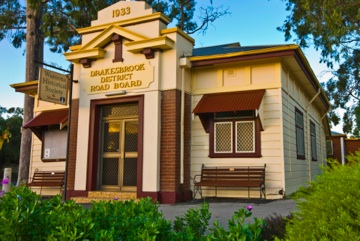History
Waroona - In The Beginning
From the days when Aboriginal people roamed the coastal areas in spring or summer and the hills in winter, the Waroona area has provided a home and a challenge for generations.
Settlers began to arrive in the area in the late 1830's, although Drakesbrook (later to be known as Waroona) did not come into its own until the Pinjarra to Picton railway line was opened on August 22nd, 1893. The town was boosted by the building of the railway, for which local timber was milled, and when the railway was extended many more settlers came to the district.
The town catered to the needs of the mill workers with a post office, general store, blacksmith, a number of hotels come boarding houses, churches, doctor and dentist. The farms supplied butter, fruit and vegetables for the men of the mills, and chaff for the horse teams that hauled the logs.
As in many of the small towns of the time, dances, picnics and football formed the core of social life within the community and to this day Waroona still proves to be a successful sporting and extremely social community.
Today agriculture (beef, dairy, fresh produce and crops) as well as tourism are important contributors to the local economy.
For more detailed information on the history of the Waroona Shire please do not hesitate to visit:
- Waroona Library, Cnr Thatcher & Hesse Streets, ph 9733 7822
- Waroona Tourist and Information Centre, South West Highway, ph 9733 1506
- Waroona Historical Society President Debra Tyler on 0417 705 966 or waroonahistsoc@gmail.com
If you wish to view our Pioneer History timeline click here.
Drakesbrook Days & Waroona Years
An illustrated history of the Waroona Shire, this publication, written by Laurie Snell is available for purchase from the Shire office for $25.00 (incl GST). The book can be posted for an additional $5.00 (incl GST).

Drakesbrook Road Board



The road board was used by the Chairmen (listed below). These people decided where and when to make new roads and kept records. The records of late John Fouracre were destroyed by a fire. For the early pioneers transporting and communicating across our wide land was difficult. Most of our first roads followed the aboriginal tracks.
The former Road Board building is located on the corner of Millar Street and South Western Highway. It is now occupied by the Waroona Historical Society and Museum and if you go in there now you will see all the old documents and maybe see someone you know. In 1933 the second Drakesbrook Road Board Office opened costing ₤500. It replaced the weather board building established in 1903. In 1961 the Road Board was renamed to the Municipality of the Shire of Waroona and the Council moved to new offices on Hesse Street in 1963.
The former Road Board building became the town library until 1992, then became the tourist centre until 2002 and today the building houses the Waroona Historical Society and Museum. As you might see below, roads in Waroona are named after past Chairmen.
The main reason the Drakesbrook Road Board was set up was to solve the road problem. No one was taking care of the roads so they decided to set up a building where they can have meetings on how to solve the road problems. Roads were made to make sure people can get around town easier with carriages. The Drakesbrook Road Board formed in 1898 at a cost of 53 pounds. The second Road Board building is now occupied by the Waroona Historical Society and Museum. If you meet up with one of the elderly residents you can learn a lot about the history of Waroona.
If you come to the Museum, you can learn a lot about the history of Waroona including old photographs which are about the town, old newsletters and a lot of other historic objects. If you live in town you can donate old items to the museum. If you like looking at objects that were owned by past generations, you will love to come to this Historical Museum. Lots of people have donated to this Museum. If you do get the time to visit there are photographs of lots of different people, old newsletters, and lots of other interesting things. The kids might not appreciate them but I think you adults will totally remember this great place.
Past Chairmen
| Year/s |
Chairman |
| 1898 |
J. Sutton |
| 1899 - 1901 |
W. J. Eastcott |
| 1902 |
C. C. Thatcher |
| 1903 |
P. Fitzpatrick |
| 1904 - 1908 |
J. H. Hall |
| 1909 - 1910 |
R. Fouracre |
| 1911 - 1915 |
A. H. Henning |
| 1916 - 1918 |
R. Fouracre |
| 1919 |
J. R. Mitchell |
| 1920 - 1923 |
Jas. Hair |
| 1924 - 1928 |
P. Fitzpatrick |
| 1929 - 1931 |
C. Sheridan |
| 1932 |
S. O’Hara |
| 1933 - 1938 |
C. H. Henning |
| 1939 - 1944 |
Jas. Twaddle |
| 1945 - 1948 |
C. H. Henning |